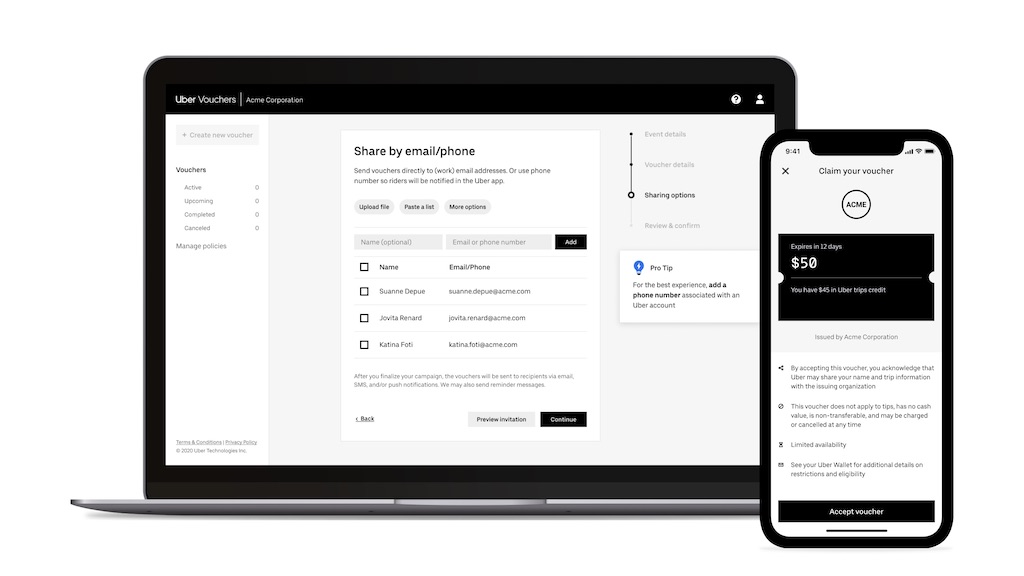Why Uber is courting retailers with branded vouchers

Uber is building out more business-geared features to court retailers.
The company, which recently completed its acquisition of competitor Postmates, just announced an overhaul of its Uber Vouchers program. The new business-facing updates allow companies to send customers credit under their own logo, which they’ll be able to distribute and manage directly from their dashboard. The program was borne out of the existing rides vouchers that companies use for employees. Now, brands can offer rides or Eats vouchers to customers in specific zip codes, giving retailers another marketing opportunity to drive sales.
The move is a way for Uber to lure retailers, making it easier to give digital perks like vouchers. The company is in a race with platforms like DoorDash to sign as many businesses as it can. Vouchers is one new tool in its marketing arsenal.
“Branding agencies in particular are excited about the ability to brand vouchers for clients,” said Michelle Lisowski, global head of marketing at Uber for Business. Lisowski pointed to Samsung as an early example of application; The tech giant used Vouchers last August to drive foot traffic into stores. The company offered customers $100 worth of Uber Eats credit with the purchase of any Galaxy phone purchase in Canada, which resulted in a 20% increase in mobile device sales during the promotional period. Lisowski also noted some other use cases too, including reward-driven surveys and the ability to bundle Vouchers with purchases to increase basket sizes.
Vouchers, which initially launched in 2019, allow businesses to create and send them via email, text and other channels; customers can redeem their vouchers on their mobile devices. Originally, businesses. Initially, Vouchers were handled by the Business team and didn’t allow for backend white label customization. The program mainly focused on one-off, event-related rides compensation. This latest iteration allows companies to make their own voucher program and have them individually branded.
The is part of Uber’s strategy to grow its overall business-to-business program, which currently counts over 150,000 worldwide partners. This year, Uber for Business expanded beyond just ride-sharing perks for corporate clients to add Uber Eats services to its offerings. Now, its business clients can offer perks to both employees and customers using services like Vouchers. The division oversaw the expansion of Uber Eats to over 20 countries. Uber for Business said that Eats users on its business-to-business platform grew 30x over the last year, and new brands onto the platform grew by 23% year-over-year in November.
As rivals DoorDash and Instacart ramped up their own retail partnerships, Uber got busy working with retailers this year. This fall, Uber Eats teamed up with The Body Shop to deliver users the brand’s skincare and beauty products locally. The partnership marked one of Uber’s very first in the beauty space, highlighting the platform’s expansion outside the food and essentials categories.
Ad position: web_incontent_pos1
Delivery services are increasingly trying to expand to new retailers and brands as they push toward profitability, said Jay Klauminzer, former vp of revenue and merchants at DoorDash and current CEO of gift card platform Raise. “The secret sauce in last-mile logistics is fleet efficiency. The more deliveries per hour these companies can get out of their drivers, the lower prices they can charge or even drop to their bottom line,” Klauminzer said. DoorDash started with food, he said, “because it’s the hardest problem to solve — getting hot food picked up and delivered while still hot and fresh.”
Now, the platforms are battling over getting as many businesses as they can sign on. For Uber, the Vouchers program is another step to attract retailers trying to handle newfound delivery and e-commerce demand. “Their teams are not only focused on local restaurants and retailers, but also with big national partners.”

